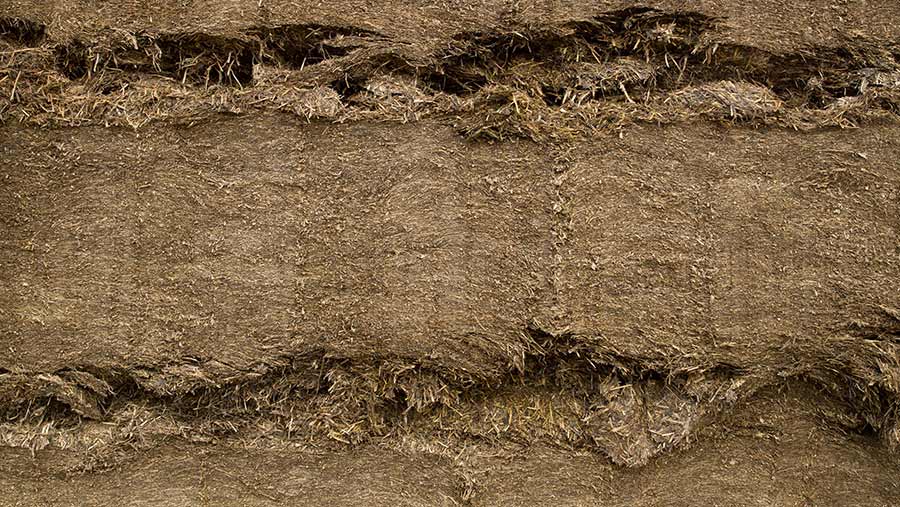6 tips to avoid mycotoxins in silage ahead of harvest
 © Tim Scrivener
© Tim Scrivener The presence of mycotoxins in silage can cause huge repercussions for livestock producers, with issues ranging from reduced feed intake to abortion often a result of a mycotoxicosis infection.
However, by employing careful silage-making and storage techniques, it is possible to minimise the risk.
We spoke to the independent consultant and director of Silage Solutions UK, Dave Davies, to find out exactly what mycotoxins are, how livestock can be affected, and what farmers can do to minimise the risk of mycotoxins in silage.
See also: Tips on reducing feed waste on your dairy
Types of mycotoxins
Mycotoxins are the toxic end product of a growth of filamentous fungi or mould.
They are produced under a range of conditions and, in nature, fungi use mycotoxins as a natural defence mechanism to kill off competitors and protect the resource they are trying to consume.
In silage, there are two different forms of mycotoxin burdens. One is created in the field during plant growth, and the other is formed in the silage clamp due to aerobic deterioration.
One of the biggest problems for farmers is that when mycotoxins are formed in the field, there is often no visible mould. Therefore, grass going into the clamp can be high quality and smell nice, but still have mycotoxins.
In contrast, when mould occurs as a result of aerobic spoilage, producers will often see this visibly (in the form of mouldy silage). But not all moulds produce mycotoxins, so it can be very hard to judge.
Effects mycotoxins have on livestock
There are a great number of issues caused by the consumption of contaminated silage, including reduced intake – and, subsequently, reduced milk yield – as well as health problems such as mastitis and abortion.
Mycotoxins are also immunosuppressants, so this can lead to a range of other animal-health related issues too.
The main problem with mycotoxicosis is that the symptoms can be the result of a number of other issues, so the possibility of a mycotoxin burden is often overlooked.
How growers can minimise and overcome the risk
While mycotoxins can have detrimental effects, there are a number of ways farmers can reduce the risk of both field-formed and in-pit mycotoxins.
1. Consider and correct field nutrition
If the field has a shortage of a particular micro or macro mineral, it can cause plants to not grow as well, which often makes them more vulnerable to mycotoxin infections.
Farmers should carry out regular soil tests and ensure they have a good nutrition plan in place to correct any issues.
It is also crucial to remember if the plant comes under stress – from situations such as drought or flooding – it is also likely to have an effect on growth, and subsequently plant health which could increase the risk of field-formed mycotoxins.
2. Optimise cutting time
One of the biggest problems with grass silage is the more mature the crop is, the more likely it is to have issues with field-formed mycotoxins.
To overcome this, it is important to ensure you cut at the optimal stage of maturity – which is preferably early.
The only real issue with this is when producing dry-cow feed, as often a stemmier crop is desired.
In this situation, try to be aware of any dead material at the bottom of the sward as this will further increase the risk.
3. Follow good ensiling management practice
One of the biggest problems is too many farmers don’t adhere to good ensiling practices, and this can lead to major problems with mould and mycotoxins in silage.
Layer forage in the pit at a maximum depth of 15cm and consolidate it well.
Aim to hit a target density of at least 700kg/cu m of fresh matter and ensure you sheet up properly.
This means overlapping the silage sheet by at least 1m – 2m if possible – and using a top sheet, followed by sufficient weight on the top to minimise the risk of spoilage.
4. Stick to a strict feed-out strategy
Farmers should look to get across the feed face every three days and use a sharp instrument for cutting the silage to avoid tearing and increasing the risk of adding air to the feed face.
The areas of a feed face that are most at risk are those around peripheral regions. Poor sealing can be a real issue too.
5. Discard any visibly mouldy feed immediately
All mouldy feed and top waste should be removed, and not fed.
Don’t give spoiled feed to the animals. Particularly when fed in a total mixed ration – it’s impossible for cows to sort it.
The best way to remove mouldy feed is not to produce it in the first place.
6. Be pragmatic about additive use
Unless everything else is done correctly, additives can be an ineffective expense.
See also: Guide to choosing and using silage additives
Additives are very much the icing on the cake, but can only potentially make a difference if everything else in the silage-making and storage process is done as it should be.
Which silage additives should you use? |
|
|
Situation |
Which additive to use |
|
Poor weather or high risk of contamination |
A chemical additive (such as acids or acid salts) |
|
Where there is slow feed-out rate, a wide clamp face or when silage will be used for buffer feeding in the summer |
An additive that controls yeasts and moulds (such as heterofermentative inoculants) |
|
Making baled silage |
Only ever treat baled silage with additives that inhibit all microbial activity or promote rapid fermentation (such as homofermentative inoculants) |
|
Making silage that includes legumes |
Legumes are less prone to aerobic spoilage, so require an additive that inhibits all microbial activity or promotes rapid fermentation (such as homofermentative inoculants) |
|
Source: AHDB |
|
